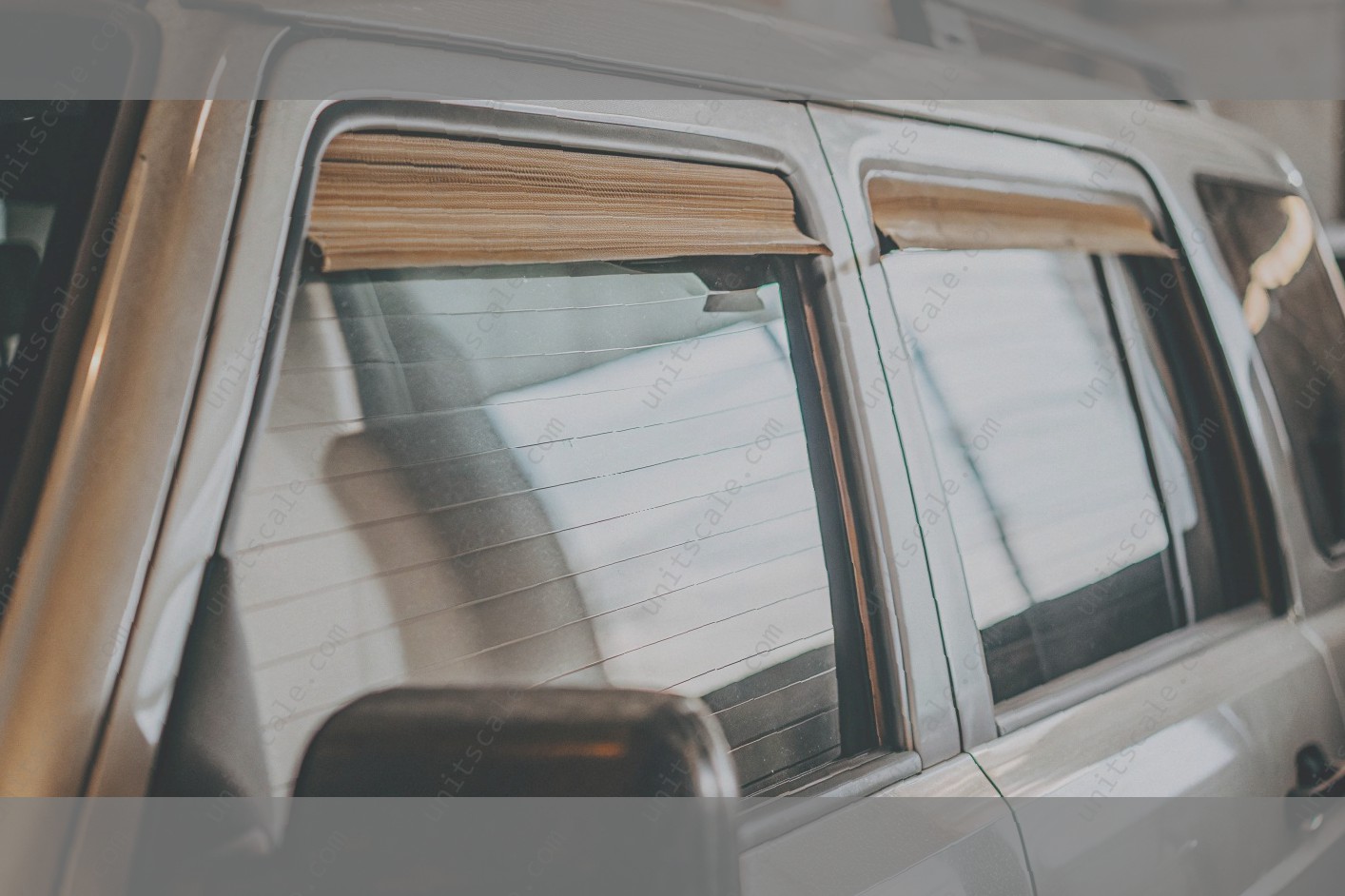Pennsylvania’s Window Tint Laws Right Now
Pennsylvania is fairly restrictive when it comes to window tint. The tint level, VLT %, will be followed the same way as other states and regions in that the % refers to the amount of light that is allowed to pass through the window. Pennsylvania state law states that for passenger vehicles referred to as SUVs or vans, the top 6" of the front windshield is allowed to have a non-reflective tint. The § 4524 (e)(1) rule about front windshield to be transparent at lower edge with tinted band at top, with AS-1 line or top edge of windshield, including tint band, maximum hue light transmission of 70%. It must also include a sticker that indicates the percentage of reflection allowed by the window tint. For the front side windows , the VLT number is 70% reflective – meaning you can have a 70% tint on the front windows of your passenger vehicle. The rear windows are fairly flexible in tint percentage. Window film tint must have a % that is more than 70%. So, basically a 70% tint is required for the rear window as well. This includes all rear side windows and the rear window of a passenger vehicle. Lastly, the back windows are again fairly flexible. There is no specification for the tint of both the back side windows and the rear window, as long as the percentage of light allowed through exceeds 70%, a100% could be used as well. However, if the back and rear window use 100%, then the use of side mirrors is required and both side mirrors must be in good condition. Drivers of some SUVs may be able to ride without side mirrors if the rear window tint is otherwise legal.

Why Does Pennsylvania Regulate Window Tint?
Additionally, these window tint laws are in place to address both safety and visibility, which are in place for the following reasons: Vehicle accidents are the leading cause of death for teenagers; windshields are especially susceptible to auto accidents and vehicle collisions, often leading to preventable deaths and other injuries; police officers cannot be seen clearly at night in cars with heavily tinted windows, putting them at a dangerous disadvantage; and smaller details are hard to decipher through tinted windows at night, including turn signals and brake lights, as one or more vehicles collide. It would be unsafe for drivers and passengers of vehicles with dark tint to ride in the presence of sudden reversing traffic or nearby breaking traffic, and this is precisely the reason why there are so many warnings and citations for illegal window tint. Pennsylvania window tint laws are strict because people can be injured or killed due to tint, and tinted windows cause a host of other safety issues.
Penalties for Illegal Window Tint in PA
If you own a car in Pennsylvania and it is not tinted in accordance with the law, you could find yourself hit with a hefty fine or even worse. If your window tint is over 70%, police are known to use discretion when pulling people over; however, once they pull you over for another reason (like driving too close to a fire hydrant), and notice that your window tint is too dark, your illegal window tint could end up costing you big time.
On the first offense (dark window tint illegally is an offense), the fine is typically $25. However, on the second or third offense, the fines continue to increase and could end up costing you $100 or more, especially if combined with other offenses. In Pennsylvania, a fourth offense could lead to an arrest. Not only could you end up paying fines and court costs, but you could lose your license temporarily, which is a major inconvenience that can impact your work and personal life.
However, probably the most annoying consequence of illegal window tints has to do with passing a vehicle inspection. Failed vehicle inspections cause car owners to pay for unnecessary repairs, spend time taking their car back to a garage multiple times, and return to an inspection garage after previous wasted time. This is obviously time consuming and costly, but at least you have a chance to fix your illegal window tint.
How to Get Your Tint Approved in Pennsylvania
To ensure that your vehicle is compliant with the law, you should select your window tint carefully. To guarantee this, the first step is to select films or tint that meet Pennsylvania’s legal standards. This means that it is imperative to only work with the most trusted and top-rated windscreen tint shops in Pennsylvania. In addition, the tint can only be installed on the windows of your vehicle, not on the windows of the trunk. It is also important to bear in mind that even if you select low-density tint, the tint must still fall within the specified range: on passenger vehicles , 70% VLT minimum; on SUVs and vans, 50% VLT minimum. You will then want to have your window tint installed by a professional who is able to guarantee its durability and long-lasting adherence. It is advisable to have the upper windshield tinted with a strip, which typically cannot be larger than five inches. When your tint is installed, you must also register it in Pennsylvania’s Department of Transportation, Bureau of Traffic Safety, beginning in 1982. To do this, you will have to complete the application form, paying the requisite fee, and submitting it to the Bureau of Traffic Safety.
Window Tint Exceptions and Medical Waivers
Separately from the legal window tint restrictions and requirements in Pennsylvania, window tint permits are also available for conditions like increased sensitivity to light, temporary medical issues, or certain medical conditions. A note from a licensed medical professional would be required to apply for a permit for medical window tint, and it must be in a particular format in order to be admissible.
If you have a medical condition that you think warrants an exception or special permission for your window tint, you can apply to the Pennsylvania Bureau of Motor Vehicles (BMV) for a window tint permit. This is in addition to the tint used on the glass and must be applied to the top of the tinted area.
Pennsylvania window tint permits will last for 5 years and then need to be renewed. Pennsylvania tint permits can be issued for both front and back windows of the vehicle, but a tinted strip will be required on the windshield in order to have tint on the front windows. The tinted strip cannot extend more than 6 inches down from the top of the windshield, in accordance with state law, and then would be protected by the permit.
Car tint permits must be applied for through the Pennsylvania BMV and will only be issued to "persons who suffer from a serious medical condition or have a situational need for a window tint that is inconsistent with the Commonwealth’s vehicle code." Permits are issued for back and side windows only. Permits are valid for five years and may be renewed.
Medical tint permits will be issued for medical reasons only, including "being light sensitive, having a medical condition where ultraviolet (UV) light should not be absorbed by the skin, or being sun sensitive." There must be a note from the physician submitted with the permit application for a medical window tint and/or on file with the Pennsylvania BMV. The doctor’s note must state that the patient has "a medical necessity" for darker window tint, and the note must be on the letterhead of the physician’s practice or facility.
People applying for a medical tint permit are responsible for obtaining the special tinted glass through a vendor that is approved by the state of Pennsylvania.
Permits are subject to revocation by the Pennsylvania BMV if:
- Additional tint is added to the tinted glass;
- The tinted glass is removed and not replaced;
- Equipment or additional tint is applied to an untinted window;
- The tinted glass receives damage that substantially alters the tint;
- Medical documentation is not maintained by the permit holder; or
- Vehicle modifications are made that would otherwise not be allowed under the Pennsylvania vehicle code.
How to Choose Legal Window Tint
When selecting legal window tint for your vehicle in Pennsylvania, start by checking the brand name and product specifications. Reputable companies provide detailed descriptions, which should indicate whether their products meet Pennsylvania’s laws.
Next, verify the Visible Light Transmission percentage. Most reputable tinting shops will show you a band of VLT options on a sample window. While a smaller window is not as obvious, if the optical safety of the tinting is important to you, ask for the VLT specifications of the tint and a glance at the layer of tint before it is put onto the window and installed. It’s harder to put something on your window that isn’t on their approved tint list.
If you want legal tint applied to your windshield, select one with an AS-1 or AS-2 tint. Pennsylvania law requires tinting to be applied to the windshield it must begin no higher than the AS-1 line or top five inches of the windshield measured from the top of the windshield, whichever is higher , as long as it is not darker than a VLT of 70%. The reason the limit is specifically for an AS-1 or AS-2 line is that most manufacturers have a template of an AS-1 or AS-2 line and can more easily place the laminate that matches these lines without having to custom fit it to the window. However, the tint cannot be darker than 30% legal tinted windows with 70% VLT. It can only be placed in those top five inches legally since you cannot get a rear tint like a sedan can to blockage.
Tint also comes with different specifications in terms of shading, heat rejection, and UV protection. If you are someone who gets a lot of sun through the window, you may appreciate the darker tinting as the heat rejection is higher.
However, if you are purchasing a legal tint for an older or classic vehicle, you may need custom fit patterns. In those instances, it is often the case that a strip of tint is placed at the top of the windshield, commonly referred to as the "eyebrow" of the windshield. Most reputable companies will have a pattern they can trace, however, not all do. Make sure your company has a pattern as it is safer getting a pattern that it safely secure to the window.

